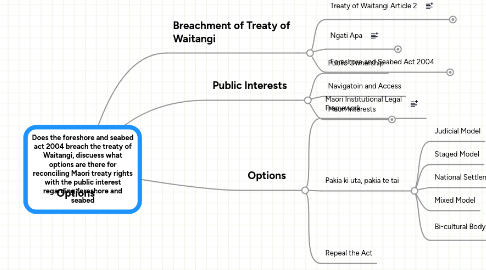
1. Options
2. Breachment of Treaty of Waitangi
2.1. Treaty of Waitangi Article 2
2.1.1. The Queen stipulated in the Treaty that we should retain the mana of our lands, the mana of our forests, fisheries, pipi grounds and other things (…). (Eruena Paerimu at Ōrākei, 1879,11 cited in 4-97-1, Merata Kawharu and Don Wackrow on behalf of Ngāti Whātua o Ōrākei Māori Trust Board)
2.2. Ngati Apa
2.2.1. That was untill Ngāti Apa decided they wanted to make a mussel farm, but were ultimately denied by numerous places
2.2.2. The High-Court Appealed case "The Attorney General vs Ngāti Apa" stated that the maori landcourt had the power to make decisions of the FandSb
2.3. Foreshore and Seabed Act 2004
2.3.1. Government were mounting. They didnt wait the alienation of substational areas aswell as access to the coastline, and when they created the maori land courts, they never wanted it to be able to do f and sb - clarify status
2.3.2. Response
2.3.2.1. It gave owner to crown, and gave limited avenues for appeal to Maori
2.3.2.2. Said it was rushed and out of tune with prior New Zealand History Laws, also didnt give Ngati Apa to finshed a good Extensive chance to battle this out more
2.3.2.3. This led to the hikoi, bringing the issues to the forefront of discussion
2.3.2.3.1. Failure to uphold due democratic process
2.3.2.3.2. "Instrument of confiscation"
2.3.2.4. Not much has happened since then, further highlighting the notion of breachment.
3. Public Interests
3.1. Public Ownership
3.2. Navigatoin and Access
3.3. Maori Interests
3.3.1. Same as they have been since Orakei
3.3.1.1. Kaitiakitanga, Mana ātua, mana tūpuna, mana moana, mana whenua
4. Options
4.1. Maori Institutional Legal Framework
4.2. Pakia ki uta, pakia te tai
4.2.1. Judicial Model
4.2.2. Staged Model
4.2.3. National Settlement Model
4.2.4. Mixed Model
4.2.5. Bi-cultural Body
